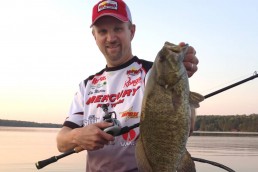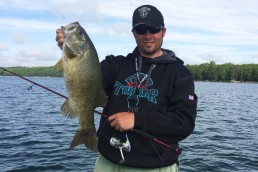SHARE THIS POST
There are factors that draw in apex predators into dense weed growth as water temperatures peak in midsummer. Lush weed beds that feature a canopy of surface vegetation provide shade from the sun, reducing the temperature of the water beneath by several degrees. Also, as the lake’s forage base explodes with young panfish and other baitfish, these tasty treats retreat into weedy cover for shelter and the chance to survive another day.
For our favorite gamefish, these compelling features make the weedy jungle a supremely attractive location to remain cool and fed during the summer. Anglers have two options for extracting bass from heavy weed growth: call fish to the surface using topwater presentations or punch through the canopy to tempt fish with heavy jigs.
Fish on top
During low-light periods, it’s tough to beat a topwater presentation. Hard baits that feature an array of weed-attracting treble hooks are poor choices when fishing in and near heavy cover. Instead, select soft-bodied topwaters with a frog, mouse or sunfish profile. These baits are heavy enough to cast long distances, are properly weighted to ensure that hook points ride safely on the topside of the bait and have supple bodies that readily collapse in the fish’s mouth during the hook-set.
Effective topwater presentations require attention to detail regarding line and rod selection. Baits should be tied directly to either monofilament at 20- to 30-pound test or a 50- to 60-pound-test braided “superline.” Each of these has particular strengths and weaknesses. The forgiving stretch of monofilament can provide some advantages on the hook-set, making it more likely that baits will travel far enough into the fish’s mouth after the initial bite to allow for positive hook penetration. This characteristic is generally a short-range advantage, however, line stretch can make hook-sets challenging at the far end of a long cast. No-stretch braided lines make it possible to drive hooks home at longer distances and are excellent at cutting through weeds when fighting a fish. However, the limpness of a superline can also lead to frustrating tangles with the bait and its hooks, reducing the number of effective casts made on any given trip.
The best topwater rods are generally in the 7- to 8-foot range to maximize casting distance and leverage while fighting a fish. Choose a rod with fast action for accurate casts and heavy power for the backbone needed to move fish out of the jungle and into the boat.
Two basic retrieves are useful for topwater presentations in and near heavy cover. When casting into the heart of the weed bed, move the bait slowly toward the boat using a series of short hops. Work plenty of pauses into your cadence as well as instances when you twitch the bait while it remains in one place. When fishing the edges of the heavy cover, a traditional “walk-the-dog” retrieve is often best. Strikes on topwater presentations are vigorous and exciting to witness, but it’s critical that the surface attack doesn’t lead to a premature hook-set. Train yourself to wait until you feel the fish before driving the hooks home. You may still miss some, but your hooking percentage will increase dramatically if you pause briefly between the strike and your response.
Are you enjoying this post?
You can be among the first to get the latest info on where to go, what to use and how to use it!
Fish down below
The jungle may appear impenetrable when observed from above, but the water below is frequently quite open, inviting both predator and prey. During the heat of the day it can be difficult to tempt fish to strike surface baits. However, if we can punch through the vegetative ceiling, we will often be rewarded with consistent catches of bass as well as the other predators that are drawn to these shaded waters. Casting and retrieving baits through thick cover is futile, so focus instead on vertical presentations using heavy baits, stout line and powerful rods to extract our finned quarry. This technique is often referred to as “punching.”
Bait, line and rod selection for punching through thick surface cover is straightforward. Select heavy, rubber-skirted jigs, typically in the 1- to 2-ounce range, dressed with a soft plastic craw or creature bait. Tungsten jigs can afford some advantages, as this dense alternative to lead allows the angler to use a smaller-profile jig at any particular weight while providing a better “feel” for the bottom and its composition. Darker-colored jigs and trailers in the blue-green-brown color palette tend to be the most effective, as they mimic the panfish and crayfish forage that is abundant in the jungle. Fluorocarbon lines at 20- to 40-pound test are excellent choices for the punching presentation. The low-stretch characteristics of fluorocarbon make for powerful hook-sets while its enhanced abrasion resistance guards against line failure as it is wrapped around and repeatedly pulled across dozens of tough weed stalks and stems. Fluorocarbon’s ability to withstand small nicks and cuts also makes it easier to land toothy critters like walleyes, pike and muskies that are also found beneath the green weed canopy.
The best punching rods are frequently in the 7- to 8-foot range for enhanced leverage over hooked fish and extend an angler’s presentation range from any one position. Remember, because we are dropping the jig vertically through the cover, a longer rod allows you to probe more water from each spot before moving your boat 10 to 15 feet to explore another area. Punching rods often have heavy power to manhandle hooked fish through cover, and a moderate-fast-action rod’s flex extends farther down the blank than just the tip. This softer action also acts as the shock absorber that’s needed when fighting fish in very close quarters.
The punching presentation is an exceptionally simple, vertical technique. Drop the jig/creature combo through the jungle canopy until it hits the bottom. Engage the reel and jiggle the bait on the bottom. Pause briefly, and then jiggle again. After a second pause, if a strike does not occur, retrieve the bait and repeat the drop-and-jig cycle in a new spot, as repeated lift-drop cycles are rarely effective. Punching tends to work best with limited horizontal bait movement so most will use a shallow-water anchor system to lock their boat in place as they work systematically through a large weed bed. Key features to concentrate on include interfaces between different weed types and pockets of sparse weed growth within an otherwise lush weed bed. Such characteristics are often coupled to changes in bottom composition—the isolated hard-bottom sweet spots within an expansive soft-bottom area can attract bass from long distances and hold them for many seasons in a row. These high-percentage areas should become part of your milk run of midsummer bass hot spots.
Whether you fish up on top or down below, lush weed beds offer outstanding bass opportunities. These tandem presentations for fishing in the jungle are your keys to success as water temperatures rise to their peak.
MWO
SHARE THIS POST
Did you enjoy this post?
You can be among the first to get the latest info on where to go, what to use and how to use it!
MWO
We believe being outdoors is good. With more than 1,000 articles each year, MidWest Outdoors magazine is all about sharing outdoor experiences with you—where to go, what to use and how to use it… whether you’re close to home or on that trip of a lifetime.



